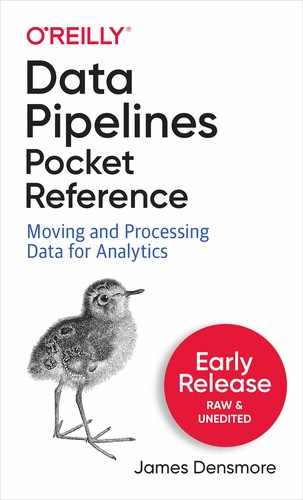Preface
Data Pipelines are the foundation for success in data analytics and machine learning. Moving data from numerous, diverse sources and processing it to provide context is the difference in having data and getting value from it.
I’ve worked as a data analyst, data engineer and leader in the data analytics field for over 10 years. In that time, I’ve seen rapid change and growth in the field. The emergence of cloud infrastructure, and cloud data warehouses in particular, has created an opportunity to rethink the way data pipelines are designed and implemented.
This books describes what I believe are the foundations and best practices of building data pipelines in the modern era. I base my opinions and observations on my own experience as well as those of industry leaders who I know and follow.
My goal is for this book to serve as a blueprint as well as a reference. While your needs are specific to your organization and the problems you’ve set out to solve, I’ve found success with variations of these foundations many times over. I hope you find it a valuable resource in your journey to building and maintaining data pipelines that power your data organization.
Who This Book Is For
This book’s primary audience is current and aspiring data engineers as well as analytics team members who want to understand what data pipelines are and how they are implemented. Their job titles include Data Engineers, Technical Leads, Data Warehouse Engineers, Analytics Engineers, Business Intelligence Engineers and Director/VP level analytics leaders.
I assume that the audience has a basic understanding of data warehousing concepts. In order to implement the examples discussed, you should be comfortable with SQL databases, REST APIs, and JSON. You should be proficient in a scripting language such as Python. Basic knowledge of the Linux command line and at least one cloud computing platform is ideal as well.
All code samples are written in Python and SQL, and make use of many open-source libraries. I use Amazon Web Services (AWS) to demonstrate the techniques described in the book, and AWS services are used in many of the code samples. When possible, I note similar services on other major cloud providers such as Microsoft Azure and Google Cloud Platform. All code samples can be modified for the cloud provider of your choice, as well as for on-premises use.
Conventions Used in This Book
The following typographical conventions are used in this book:
- Italic
-
Indicates new terms, URLs, email addresses, filenames, and file extensions.
Constant width-
Used for program listings, as well as within paragraphs to refer to program elements such as variable or function names, databases, data types, environment variables, statements, and keywords.
Constant width bold-
Shows commands or other text that should be typed literally by the user.
Constant width italic-
Shows text that should be replaced with user-supplied values or by values determined by context.
Tip
This element signifies a tip or suggestion.
Note
This element signifies a general note.
Warning
This element indicates a warning or caution.
Using Code Examples
Supplemental material (code examples, exercises, etc.) is available for download at https://github.com/oreillymedia/title_title.
If you have a technical question or a problem using the code examples, please send email to [email protected].
This book is here to help you get your job done. In general, if example code is offered with this book, you may use it in your programs and documentation. You do not need to contact us for permission unless you’re reproducing a significant portion of the code. For example, writing a program that uses several chunks of code from this book does not require permission. Selling or distributing examples from O’Reilly books does require permission. Answering a question by citing this book and quoting example code does not require permission. Incorporating a significant amount of example code from this book into your product’s documentation does require permission.
We appreciate, but generally do not require, attribution. An attribution usually includes the title, author, publisher, and ISBN. For example: “Book Title by Some Author (O’Reilly). Copyright 2012 Some Copyright Holder, 978-0-596-xxxx-x.”
If you feel your use of code examples falls outside fair use or the permission given above, feel free to contact us at [email protected].
O’Reilly Online Learning
Note
For more than 40 years, O’Reilly Media has provided technology and business training, knowledge, and insight to help companies succeed.
Our unique network of experts and innovators share their knowledge and expertise through books, articles, and our online learning platform. O’Reilly’s online learning platform gives you on-demand access to live training courses, in-depth learning paths, interactive coding environments, and a vast collection of text and video from O’Reilly and 200+ other publishers. For more information, visit http://oreilly.com.
How to Contact Us
Please address comments and questions concerning this book to the publisher:
- O’Reilly Media, Inc.
- 1005 Gravenstein Highway North
- Sebastopol, CA 95472
- 800-998-9938 (in the United States or Canada)
- 707-829-0515 (international or local)
- 707-829-0104 (fax)
Email [email protected] to comment or ask technical questions about this book.
For news and information about our books and courses, visit http://oreilly.com.
Find us on Facebook: http://facebook.com/oreilly
Follow us on Twitter: http://twitter.com/oreillymedia
Watch us on YouTube: http://www.youtube.com/oreillymedia
